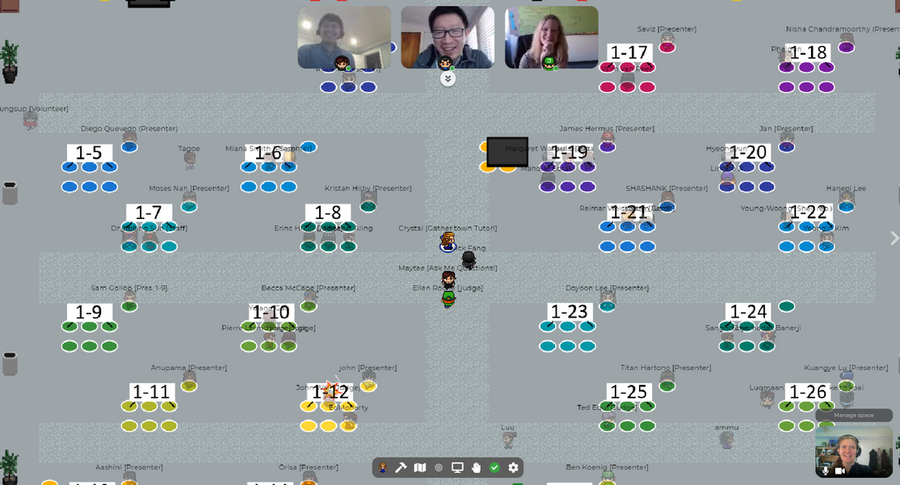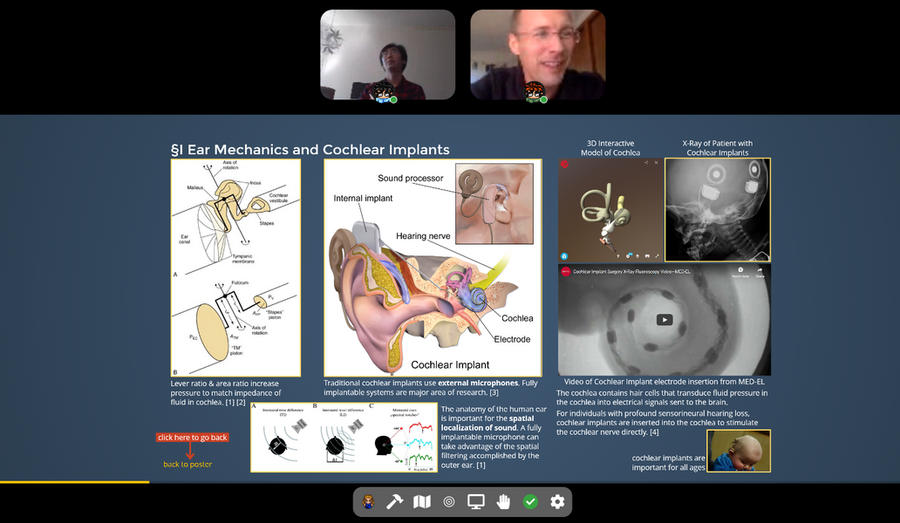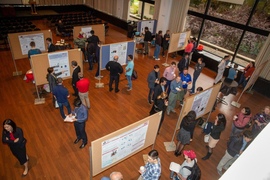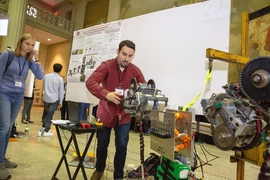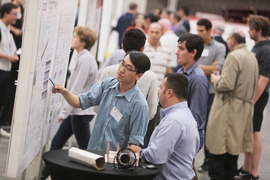Each fall, graduate students, undergraduate students who have completed Undergraduate Research Opportunities Program (UROP) projects, and postdocs gather to share their mechanical engineering research with the wider MIT community. They practice their presenting skills, explaining their research projects as attendees snake through rows of posters — a sight familiar to anyone who has attended a scientific conference.
As with most events and conferences, the Mechanical Engineering Research Exhibition (MERE) had to be held virtually this year. This presented the student organizers with a challenge: How could they help foster the discussions that happen organically as people physically walk through poster sessions in a virtual space?
“Our main goal was to recreate the poster presentation experience, with as much person-to-person interaction as possible,” says graduate student Crystal Owens, who was a co-organizer of the event.
Early in the summer, when it became clear that MERE would have to be a virtual event, Owens and her fellow co-organizer Maytee Chantharayukhonthorn, also a graduate student in mechanical engineering, started researching platforms that could help them recreate the poster session experience.
After discussing with friends, the pair narrowed down a list of 10 options and performed beta testing with students, faculty, and staff. They chose the video game-like platform Gather.town, which enables people to choose avatars and walk through a virtual space. Once their avatar gets close enough to another user’s avatar, a video chat pops up, allowing people to talk with each other as they would during any virtual meeting.
Owens got to work building a virtual environment that looked like a typical poster session. Presenters and their avatars were stationed at their posters, which users could click on to view as a PDF. As attendees moved their avatar around the “room,” they could approach individual presenters and posters to start a conversation or join an existing conversation, just like an in-person poster session.
“I've always liked video games, so I had fun creating the map and putting our event rooms together,” says Owens, who also added small "Easter eggs," such as a hidden map with MIT’s dome with a police car on top.
The team managed to create a virtual event that was as close to an in-person poster session as possible.
“Seeing people actually walking around from poster to poster, and people chatting in groups, was exactly what we were hoping would happen,” adds Chantharayukhonthorn. “That sort of organic community-building experience was important to us.”
Hosting the event virtually for the first time had some unexpected benefits. Individuals across the wider MIT community were able to join the virtual keynote speech delivered by Norman L. Fortenberry '83, SM '84, SCD '91, executive director of the American Society for Engineering Education.
Additionally, alumni from as far away as Turkey were able to join the event as judges and participants. Judges, including faculty, staff, alumni, and industry representatives, spoke with each student and voted for categories like First Place Presenters, Best First-time Presenters, Best UROPs, Runners-up, and two new awards this year — Best Lightning Talk and Most Innovative Use of Virtual Environment.
“I think the posters are great examples of how our students stay passionate in their scientific research and demonstrate resilience to get through the tough times,” says Nicholas Fang, professor of mechanical engineering and faculty advisor for MERE.
Among the award winners were the following First Place Presenters:
Orisa Coombs: “Multi-component Solution Diffusion Model for Forward Osmosis”
While desalination can help improve access to water globally, it is often expensive. A low-energy process known as OARO — osmotically assisted reverse osmosis — could help lower desalination cost. However, little is known about membrane diffusion in OARO systems.
As part of a UROP with Professor John Lienhard, Orisa Coombs, a senior studying mechanical engineering, developed a computational model of OARO that correlated with experimental data better than existing models.
“We hope that this research will serve to better inform designers of desalination systems and make desalination plants a viable primary water source in the future,” says Coombs.
Sangho Lee: “Nanopatterned Graphene-based Universal Epitaxy Platform for Single-crystalline Membrane Transfer”
Sangho Lee, a graduate research assistant working in the lab of Associate Professor Jeehwan Kim, won a First Place Presenter award for his work on epitaxy — a process vital to the fabrication of semiconductors. In the research he presented at MERE, Lee expanded the materials that could be used in remote epitaxy, a method previously developed by Kim that could substantially reduce the cost of semiconductor manufacturing.
“We found out nanostructured graphene provides a universal epitaxy platform from which we can accommodate the growth, release, and transfer of any high-quality membranes of interest,” says Lee.
Lee will continue his work in fabricating device-level structures such as curvilinear focal plane arrays.
Moses C. Nah: “Dynamic Motor Primitives Facilitate Flexible Object Manipulation – A Study with A Whip”
While the field of robotics has advanced greatly in the past decade, there are still many tasks that robots simply cannot perform as well as humans. One such task is controlling flexible objects. Moses Nah, a graduate student working with Professor Neville Hogan, set out to improve robotic performance in handling flexible objects, like a whip.
The team encoded the robotic controller with structures called “dynamic motor primitives.”
Encoding the robotic controller with these dynamic primitives dramatically simplified the acquisition of the motor skills needed to control an object with many degrees of freedom like a whip, which was modeled as a 54 degrees-of-freedom model for the presented case.
“Ultimately, we want to establish a fundamental understanding of humans’ remarkable motor performance, and apply this understanding to improve machines and robots,” explains Nah, who is currently in South Korea and presented at midnight his time.
Youngsup Song: “Micro-tube Arrays for Enhanced Pool Boiling Heat Transfer”
Boiling water is crucial to the creation of energy. Power plants, steam engines, and concentrated photovoltaics rely on boiling for efficient energy generation. In previous studies, researchers have found that surfaces with microcavities increase the efficiency of boiling heat transfer, while permeable structures with micropillar arrays improve what is known as the “critical heat flux.”
In his research with Professor Evelyn Wang, Youngsup Song, a graduate student studying mechanical engineering, utilized both microcavities and micropillar arrays to increase the efficiency in boiling heat transfer.
“In our work, we combined the two features — micropillar and microcavity — in one structure, such as a microtube, so that simultaneous enhancement of maximum heat flux and efficiency was achieved,” explains Song.
Other award winners at MERE include the following:
Best First-Time Presenters
- Carlos Diaz
- Rebecca McCabe
Best UROPs
- Anupama Phatak
- Ruben Castro
- Miana Smith
Runners-up
- Benjamin Koenig
- Caroline McCue
- Ryuichi Iwata
- Kaymie Shiozawa
- Tom Dillon
- Saviz Mowlavi
- Xia Fangzhou
- Sreedath Panat
- Stacy Godfreey-Igwe
- Yeongin Kim
Honorable Mentions
- Swathi Manda
- Tyler Hamer
- Chad Wilson
- Ben Miller
- Doyoon Lee
- John Zhang
- Nisha Chandramoorthy
- Titan Hartono
- Golnaz Isapour
- Shashank Agarwal
- Rabab Haider
Audience Award: Best Lightning Talk
- Tom Dillon
- James Gabbard
Audience Award: Most Innovative Use of Virtual Environment
- John Zhang
- Sreedath Panat
